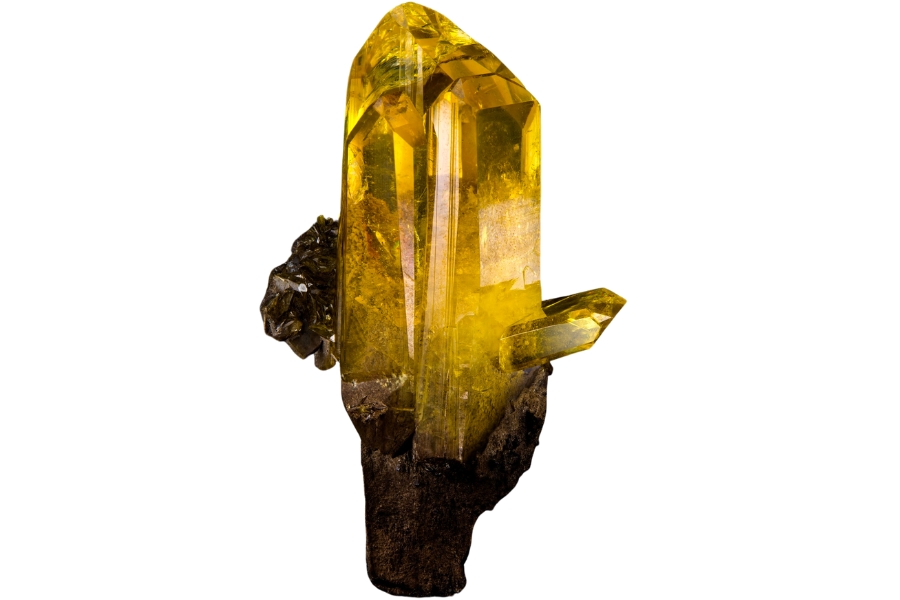Yellow is a vibrant, eye-catching color that has captivated people for centuries. From the sun to precious stones to minerals, yellow has been used to symbolize wealth, power, and beauty.
Gems are a popular choice when it comes to collecting beautiful yellow objects. Citrine, golden beryl, and heliodor are just some of the many varieties of yellow gemstones available today.
Rocks can also come in various yellows, ranging from light butterscotch hues to deep ochres and oranges. Some famous examples include sandstone and quartzite, which have been used in construction for centuries.
More recently, some rock formations have been unearthed that contain astonishingly bright yellow minerals.
This article will explore some of nature’s most elegant yellow gems, rocks, and minerals. So if you’re looking for a unique yellow item to add to your collection or want to learn more about these fantastic natural objects, read on!
Yellow Gems
The following are some of the most beautiful and exciting yellow gemstones that can be found across the world:
Amber – C,H,O
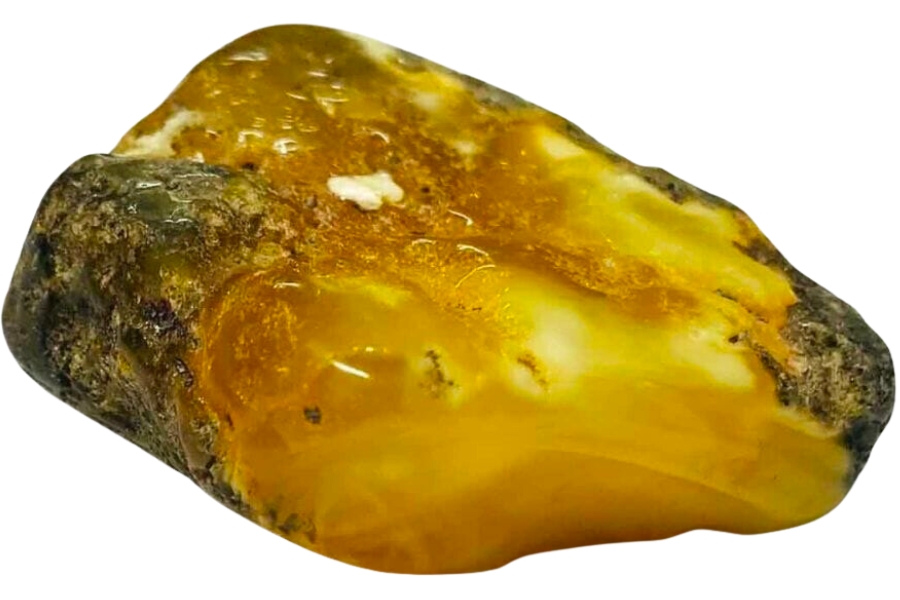
Amber is a precious gemstone formed from fossilized tree resin. It has been used in jewelry and decoration since prehistoric times and was popular among the ancients, particularly in Europe.
It comes in various colors, from yellow to red, orange, and blue. Amber is believed to have healing properties, provide protection against negative energy, and bring good luck. Its use as a healing stone dates back to Ancient Greece and Rome.
The Chinese have also used Amber for centuries to treat ailments such as headaches, joint pain, anxiety, depression, and even infertility. In modern times, amber is still highly sought after for its beauty and unique properties.
Fun Fact
Did you know that Amber is the birthstone for the astrological sign of Cancer? It is believed to mirror the energy of the sunniest and warmest month of the year in the Northern Hemisphere, where it is located.Where Ambers are found
You can find Amber in different areas of the world, including India, the Dominican Republic, Mexico, and the Baltic region.
How you can identify an Amber
Color
Amber is a translucent, warm-toned yellowish-orange hue. It has a solid gold tone and can appear almost yellow in its lighter shades. In its darker shades, the orange tone is more prominent. The color is associated with the sun’s warm energy.
Hardness
It has a hardness rating of 2 to 2.5 on the Mohs scale, which means it can be scratched with a fingernail but not easily.
Amber can be brittle, so it should be handled with care and stored away from direct sunlight to avoid cracking or discoloration.
Clarity
Amber’s clarity is characterized by its deep, transparent color and glowing, lustrous appearance. Its clarity depends on the number of bubbles or inclusions within it, with the most sought-after pieces being those with few or no inclusions.
Refractive index
The refractive index of amber ranges from 1.53 to 1.55, depending on the angle of the light entering the material.
Specific gravity
The specific gravity of amber is typically between 1.05 and 1.09. This means that its density is slightly higher than that of water, making it somewhat denser than most other materials.
The specific gravity of amber can vary depending on the type and composition but is usually within this range.
Citrine – SiO₂
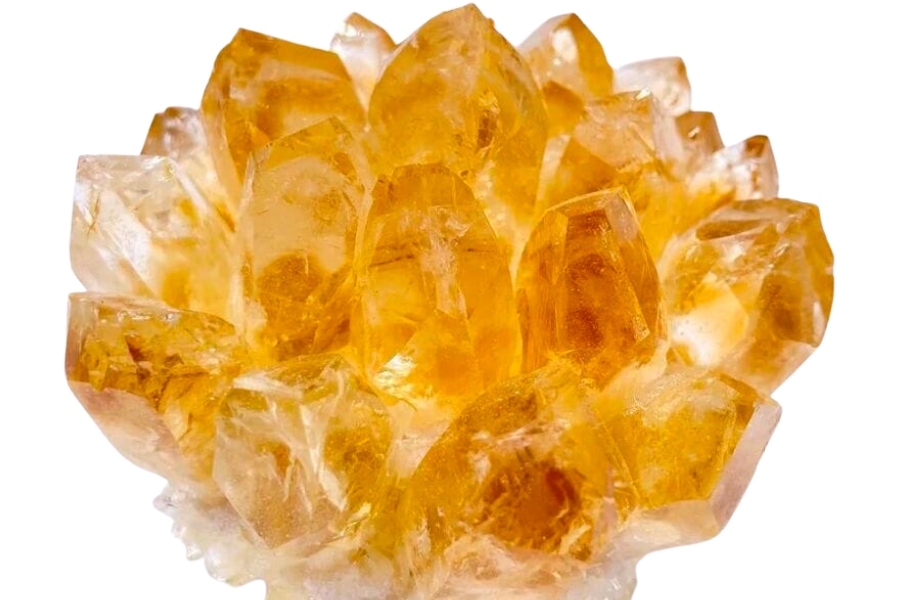
Citrine is a semi-precious gemstone with a warm, golden hue. It has been treasured for centuries for its beauty and healing properties. It is believed to bring good luck and prosperity and help clear negative energy.
Citrine can be found in nature in its purest form or produced through the heating of amethyst or smoky quartz. Its name comes from the French word “citron,” which means lemon, due to its yellowish color.
In medieval times it was known as the “Merchant’s Stone” because it was believed to attract wealth and success in business.
Ancient Greeks used it to decorate jewelry and amulets, while Romans adorned their swords with it to bring courage and victory in battle.
Today citrine is still used for jewelry making and is also considered a symbol of hope, optimism, and joy.
Fun Fact
The Emperor of Ancient China frequently wore citrine jewelry, as it was considered to be a "Success Stone" which brings success to the wearer. Where Citrines are found
Citrines can be found in various locations, including Brazil, Uruguay, Madagascar, and the United States.
How you can identify a Citrine
Color
Citrine is a bright, vibrant yellow-orange colour. It has a warm, inviting tone that evokes happiness and joy. Citrine is a unique shade of yellow-orange that stands out from the rest, creating an eye-catching look.
Hardness
Citrine has a hardness rating of 7 out of 10 on the Mohs scale. Its good durability makes it suitable for everyday wear and tear (it doesn’t easily scratch and chip!).
Clarity
Citrine is a very clear gemstone, with its clarity being one of its defining characteristics. It has a bright yellow hue ranging from pale yellow to golden brown and is often transparent or translucent.
Refractive index
Citrine has a refractive index of 1.544 to 1.553, which is higher than quartz but lower than diamond. This means it bends light at a medium level and produces a moderate sparkle.
Specific gravity
The specific gravity of a citrine is 3.6 – 3.7, slightly higher than that of quartz (2.7). This means that citrine is denser and heavier than quartz, which can be used to identify it from other stones.
Lemon Chrysoprase – SiO₂ + (Ni) + (Mg)
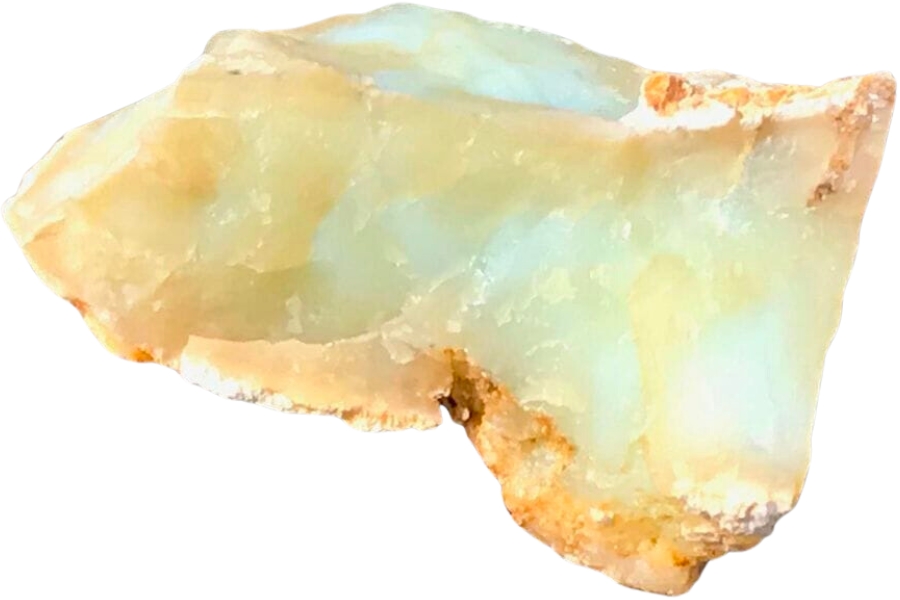
Lemon chrysoprase is a beautiful gemstone, with a bright yellow-green hue and a glossy finish. It is quite rare and has been used in jewelry for centuries.
It is believed to have first been discovered in Poland during the 18th century, although it has also been found elsewhere in Europe and parts of India and Australia.
The stone was particularly popular during the Victorian era when it was used to create stunning jewelry for royalty and the wealthy.
Today lemon chrysoprase is still highly sought after due to its rarity and beautiful colouration. It possesses many healing properties, including promoting emotional clarity, reducing stress, and calming anxiety.
Lemon chrysoprase can be found set into rings, earrings, necklaces, and other pieces of jewelry or collected as loose stones by collectors all over the world.
Fun Fact
Did you know? Lemon chrysoprase is believed to be a "stone of love" and is sometimes used as an engagement or wedding ring. It is also said to bring good luck, joy, and a sense of emotional well-being. Where Lemon Chrysoprases are found
Lemon chrysoprase can be found in Australia, Brazil, India, Madagascar, Namibia, Poland, and the United States.
How you can identify a Lemon Chrysoprase
Color
Lemon chrysoprase is a bright, vibrant yellow-green color with hints of golden yellow. Its color comes from nickel impurities in the quartz.
It has a vivid hue that can range from light to dark depending on the stone’s size and the amount of nickel present. The color has been described as similar to that of a lemon or lime, hence its name.
Hardness
Lemon chrysoprase ranges from medium to hard on the Mohs scale of mineral hardness. It has a hardness of 6.5 to 7, which can be considered quite hard compared to other gemstones or minerals.
It’s also quite durable, making it suitable where strength and durability are required.
Clarity
Lemon chrysoprase has relatively good clarity, with few visible inclusions or blemishes. Its clarity is generally described as eye-clean, meaning that any inclusions or blemishes are not visible to the naked eye.
Refractive index
The refractive index of lemon chrysoprase is between 1.517 and 1.523, slightly higher than a quartz gemstone’s average.
It has a unique birefringence that causes light to split into two rays when passing through it, producing a shimmering effect called “chatoyancy.”
Lemon chrysoprase also has an optical property known as pleochroism, where its color can appear different when viewed from different angles.
Specific gravity
The specific gravity of lemon chrysoprase is 2.6-2.7, which is slightly higher than the average specific gravity of most gemstones, which is usually around 2.6.
This means it’s slightly denser than other gemstones but still relatively light compared to other minerals.
Mali Garnet – Ca3A12(SiO4)3
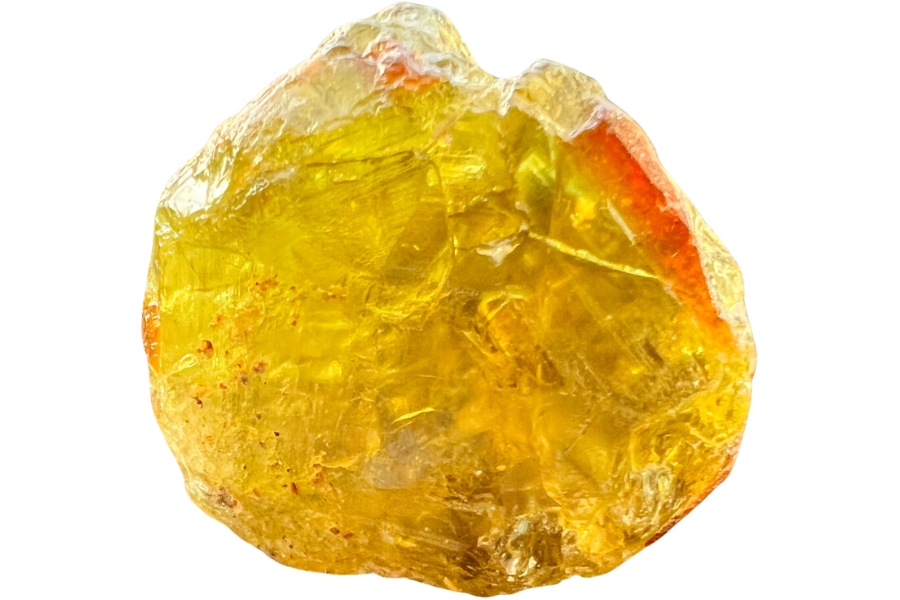
Mali garnet is a unique and rare type of garnet gemstone found in the African country of Mali. This gemstone is known for its vibrant colors, ranging from deep reds to orange-browns.
Its name comes from the Malian region of Bandiagara, where most of these stones are mined. The mines were discovered in the late 19th century and have since been mined for their gems.
Mali garnet has become increasingly popular among jewelry makers due to its rarity and beautiful colors. It is believed to bring luck, wealth, health, and protection to its wearer.
This gemstone is also thought to have healing properties and can help with mental clarity and emotional balance. Mali garnets are becoming more widely available as they gain popularity among collectors and jewelry designers.
Fun Fact
Mali garnet represent fresh starts, optimisim, and connection to the earth. It also symbolizes friendship, love, and passion. Where Mali Garnets are found
Mali garnet can be found in the alluvial deposits of the Bafing and Bakoy Rivers in western Mali. Most of these deposits are located between Bamako and Kayes, near the border with Guinea.
How you can identify a Mali Garnet
Color
Mali garnet has a lovely deep red hue, with hints of orange and yellow. It’s an eye-catching stone that will add a vibrant touch of color to any piece of jewelry it’s set in.
Hardness
Mali garnet is a very hard gemstone, boasting a hardness rating of 6.5 to 7 on the Mohs Scale, making it one of the toughest gemstones available. It’s ideal for rings, earrings, and necklaces because it can last for a lifetime with proper care.
Clarity
Mali garnets display a high level of clarity, with their clarity rating often being very good to excellent. They have an outstanding degree of transparency, with inclusions generally not visible to the naked eye, and are often described as sparkling.
Refractive index
The refractive index of a Mali garnet is typically around 1.72-1.76, making it a fairly average gemstone in terms of dispersion.
Specific gravity
The specific gravity of a Mali garnet is 3.6-3.8, slightly higher than that of other garnets.
This high specific gravity is due to the high density of the garnet, as well as its chemical composition, which consists mainly of iron-aluminum silicates and calcium-magnesium silicates.
Sunstone – (Na, Ca)Al₁₋₂ Si₃₋₂ O₈, KAlSi₃O₈
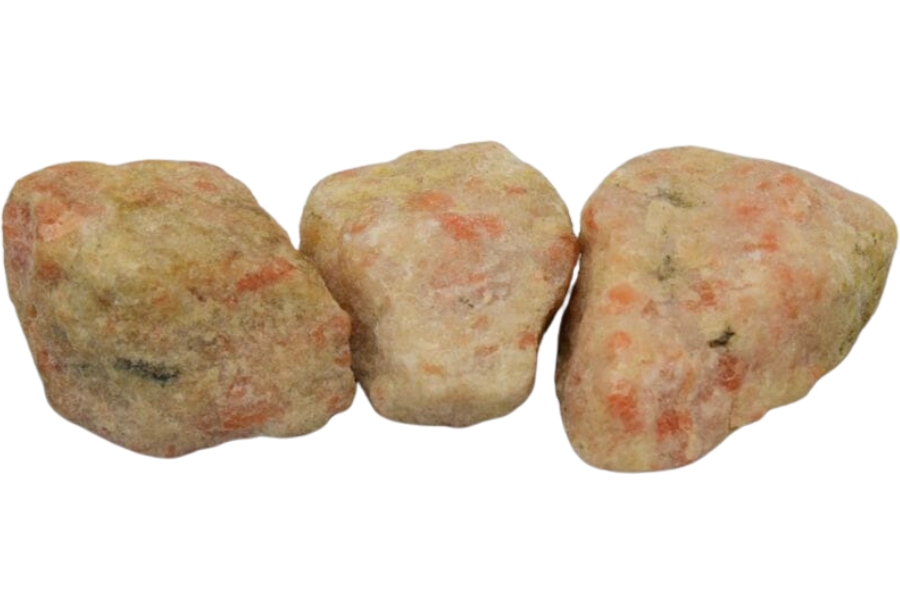
Sunstone is a semi-precious gemstone that has been treasured since ancient times. It is a form of feldspar with a bright orange-red color and metallic sheen, due to the presence of hematite crystals.
Sunstones were used in jewelry and amulets by the Vikings, and have been found in Bronze Age graves. It was also used in ancient Rome for talismans and seals and was believed to bring good luck to its wearer.
Sunstone has been used for centuries for its beauty, but also as a symbol of courage, strength, and success. It is still highly sought after for its unique color and shimmering luster, making it perfect for jewelry or decorative pieces.
Fun Fact
Its name comes from the Old Norse "Sunnusteinn", meaning sun stone. Cool, right?Where Sunstones are found
Sunstones are found mainly in Norway, Russia, and India but can be found worldwide.
How you can identify a Sunstone
Color
A sunstone can range from pale yellow and orange to reddish-brown and deep red. Depending on the angle it is viewed, it can give off flashes of green, blue, and gold.
Hardness
Sunstone has a hardness of 6-7 on the Mohs scale. It is considered a relatively soft gemstone, which can easily be scratched or damaged.
Clarity
Sunstone is known for its clarity, as it often has a high degree of transparency. It can range from transparent to translucent and has a refractive index that gives it a bright sparkle.
The stone can also have inclusions, which add depth and character to the stone’s beauty.
Refractive index
The refractive index of sunstone ranges from 1.52 to 1.54. Its birefringence is between 0.008 and 0.010, giving it high light dispersion properties and a unique sparkling effect when viewed directly by sunlight or bright light sources.
Specific gravity
Sunstone has a specific gravity of 3.56, slightly higher than quartz. Sunstone is heavier than quartz and other common minerals, making it easier to identify by its weight.
Sunstone’s higher specific gravity also makes it more resistant to erosion, giving it a longer lifespan in the environment.
Yellow Rocks
Below is a list of some of the world’s most remarkable yellow rocks ever discovered:
Carnotite – K₂(UO₂)₂(VO₄)₂·3H₂O
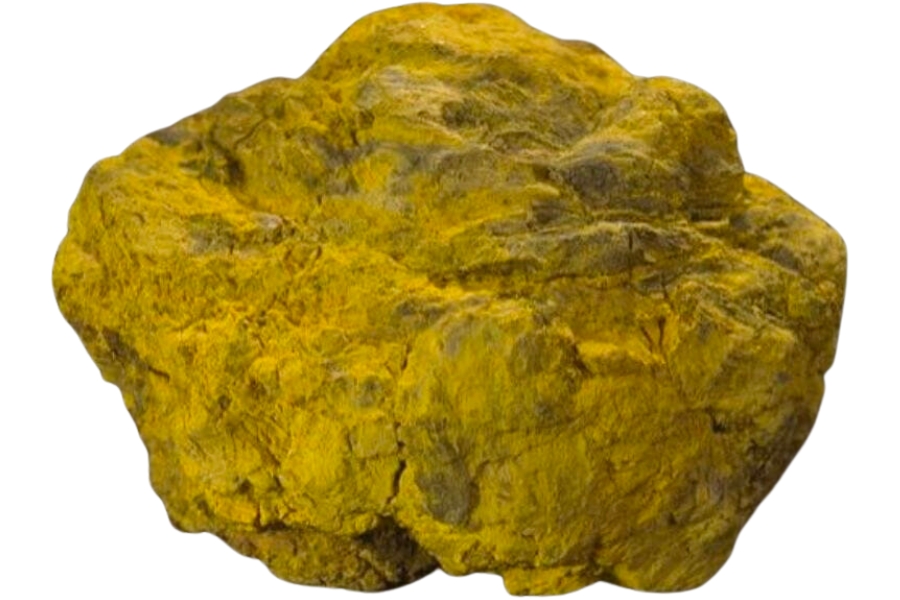
Carnotite is a uranium-vanadium oxide mineral with a yellowish-green color and may be found in sedimentary rocks, such as sandstone and shale. It was first discovered in 1841 by French mineralogist Urbain Le Fèvre.
However, it was not recognized for its uranium content until much later. The discovery of carnotite helped fuel the nuclear age, making it an essential mineral throughout the 20th century.
Today, carnotite is still mined and used for industrial purposes such as ceramic glazes and yellow pigments. In addition, it is used as an ore of uranium for radiation shielding and other applications.
Fun Fact
In the early 1900s, carnotite was identified as a source of uranium ore and began to be mined commercially for use in nuclear reactors and weapons. Where Carnotites are found
Carnotites can be found in sedimentary rock deposits in the western United States, including Colorado, Utah, New Mexico, and Arizona. They are also found in other parts of the world, including Canada, South America, Australia, and Africa.
How you can identify a Carnotite
Color
Carnotite is a yellowish-green to yellowish-brown mineral with a distinct color. It typically appears in olive green, lemon yellow, and brown shades. Its color is often described as similar to olive oil’s hue or lemon rind’s shade.
Hardness
Carnotite is a relatively soft mineral with a Mohs hardness of 2.5 to 3. It can be easily scratched with a fingernail and is slightly more difficult to scratch than talc. It has low resistance to weathering.
Clarity
Carnotite has a vitreous to greasy luster and can be described as slightly translucent.
Refractive index
Carnotite is a uranium-bearing mineral with a refractive index between 1.6 and 2.1. It has an anomalously high birefringence of 0.19 and an average absorption coefficient of 0.16.
The dispersion is also high, ranging from 0.06 to 0.07 for the violet and red rays respectively, making it useful for producing optical components such as lenses and prisms.
Specific gravity
Carnotite is between 2.9 and 3.3, making it a moderately heavy mineral. It is denser than quartz but not as dense as hematite or magnetite, two minerals with which it is often found in association.
Its density is due to its uranium content, which makes it slightly radioactive.
Sandstone – SiO₂
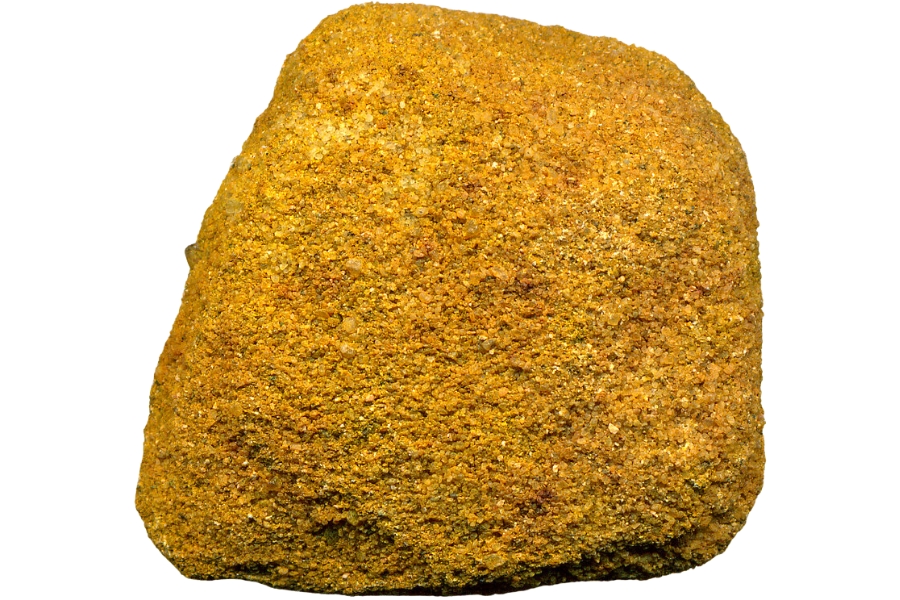
Sandstone is a sedimentary rock composed of sand-sized particles, usually quartz and feldspar. It is composed of minerals, rock fragments, and organic matter cemented together over millions of years by pressure and heat.
Sandstone has been used since ancient times for various purposes, such as building materials, monuments, sculptures, and pottery.
The stone is known for its durability and resistance to weathering, making it an ideal material for large-scale construction projects.
Its wide range of colors makes it popular in many different architectural styles. Its popularity continues today, with sandstone being used in many modern buildings across the globe.
Fun Fact
If you've been traveling the world, you might have seen sandstones more than you know. That's because it has been used in some of the world's most famous structures including the Egyptian pyramids, the Taj Mahal, and Stonehenge. What a wonder!Where Sandstones are found
Sandstone is found on the Earth’s surface in desert regions, riverbeds, and shorelines. It can also be mined from quarries and caves.
How you can identify a Sandstone
Color
Sandstone has a wide range of colors, from white to yellow, orange, red, brown, and grey. The color of sandstone depends on its composition and the environment in which it is formed.
Hardness
Sandstone has a hardness of 6-7 on the Mohs Scale, indicating it’s tougher than glass but softer than quartz.
Sandstone can be brittle and may break or crumble when struck, but it’s still considered tough and durable enough for most construction applications.
Clarity
It is typically characterized by its high level of clarity and visible grains, which are usually cemented together by either quartz, calcite, clay, or iron oxide.
Refractive index
The refractive index of sandstone is typically between 1.53 and 1.66, depending on the composition of the rock.
It can vary with the amount and type of cementing material present in the rock and its porosity. It can also change due to diagenesis or changes in pore water chemistry due to burial and compaction over time.
Specific gravity
The average specific gravity for a sandstone is typically between 2.2 and 2.9 but can range from as low as 1.5 up to 3.5, depending on its composition.
Yellow Minerals
The most extraordinary yellow minerals ever found are listed below:
Andalusite – Al₂SiO₅
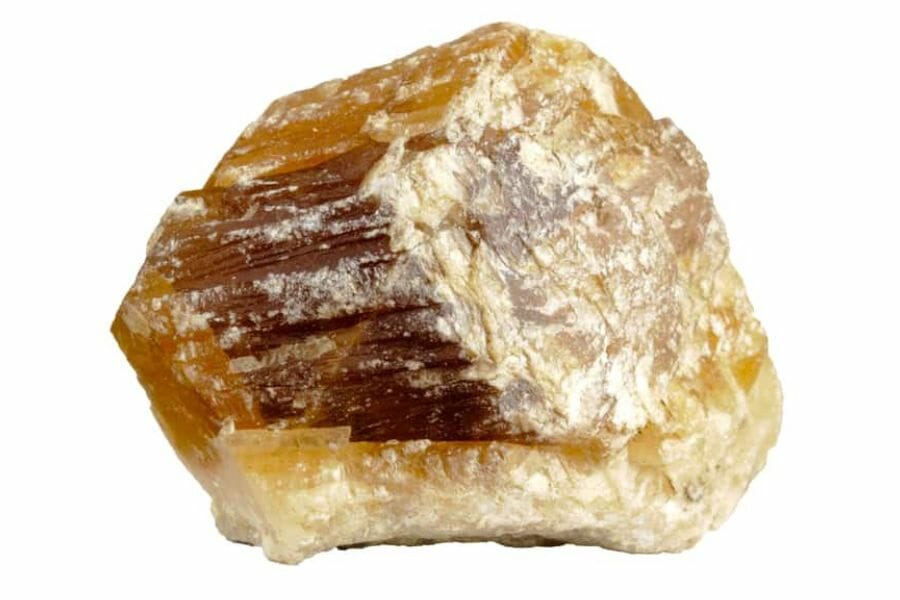
Andalusite is a naturally occurring mineral that has been used for centuries. It was first discovered in Andalusia, Spain, and named after the region where it was mined for centuries as a gemstone.
The ancient Greeks believed that andalusite could cure any illness and even bring peace of mind. In the 18th century, it was also used for jewelry making, but it wasn’t until the 20th century that its industrial applications were discovered.
Due to its high-temperature resistance, andalusite is used in ceramics, glassmaking, and refractory materials. Its optical properties are also helpful in lasers and optical fibers.
Andalusite continues to be an essential mineral with many commercial and cultural uses.
Fun Fact
Andalusite closely resembles the alexandrite stone, and it is often called the poor man's alexandrite. Where Andalusites are found
Andalusite can be found globally, including in India, Brazil, the United States, France, Spain, and Australia.
How you can identify an Andalusite
Color
Andalusite can be found in shades of yellow, green, brown, gray, and even pink. The most common color is a yellowish-green or olive green.
Hardness
Andalusite has a hardness rating of 6.5 to 7 on the Mohs scale, making it an ideal choice for jewelry and other ornamental items.
It’s considered relatively hard, but not as hard as some other gemstones, such as diamond or sapphire. Its strength makes it resistant to scratches and chips.
Clarity
Andalusite has good clarity, meaning it is transparent and translucent. It can also appear cloudy if it contains large amounts of iron oxide or other impurities.
Refractive index
Andalusite has a refractive index of 1.610 to 1.664, depending on the direction of light passing through it. The ordinary ray has a higher refractive index than the extraordinary ray.
It has a birefringence of 0.054, meaning that its two beams have a difference in index of refraction of 0.054, and it has an extinction angle of 21°.
Specific gravity
Andalusite has an average specific gravity of 3.14, which is higher than average for most minerals. It is relatively heavy for its size and can be distinguished from other similar minerals based on this property.
Chrysoberyl – BeAl₂O₄
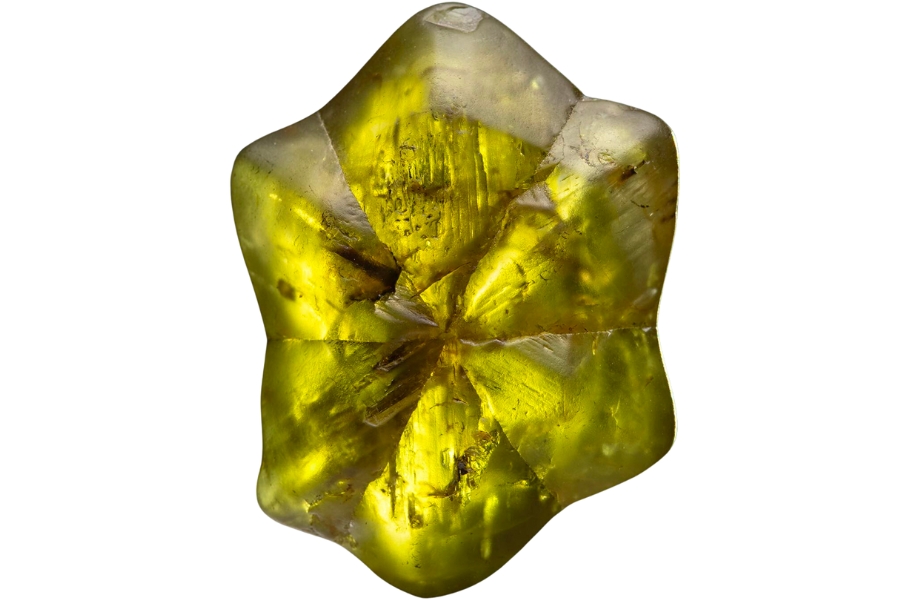
Chrysoberyl is a rare and valuable gemstone known for its remarkable brilliance and hardness. It was first discovered in 1789 by the German mineralogist Abraham Gottlob Werner.
The name chrysoberyl is derived from the Greek words ‘chrysos,’ meaning ‘gold,’ and ‘beryllos’ meaning ‘beryl.’ Chrysoberyl has been used throughout history to make jewelry and ornamental objects.
It can be found in various colors ranging from yellowish green to brownish yellow, with the most desirable color being a golden green known as ‘alexandrite.’
In some cases, chrysoberyl displays an optical phenomenon called chatoyancy, which gives it a shimmering effect like a cat’s eye when cut into cabochon form.
Chrysoberyl is treasured for its unique beauty and durability, making it a popular choice for gemstone collectors and jewelry.
Fun Fact
A magnificent 47 carats chrysoberyl is listed in the catalog of the British Museum of Natural History.Where Chrysoberyls are found
Brazil, Madagascar, Sri Lanka, and Russia are some of the most notable sources of chrysoberyls.
How you can identify a Chrysoberyl
Color
Chrysoberyl’s color goes from yellow, yellow-green, green, brown, and even a rare blue. It usually has a strong luster that gives it an attractive sparkle. Depending on the light, its colors can appear vibrant or muted.
Hardness
Chrysoberyl has a ranking of 8.5 on the Mohs hardness scale. This makes it one of the hardest natural gemstones, only surpassed by diamond and corundum.
Clarity
Chrysoberyl has excellent clarity, with its transparency ranging from transparent to translucent. Its clarity is often described as like glass, displaying few to no inclusions or blemishes when viewed under magnification.
Refractive index
The refractive index of chrysoberyl is typically 1.741-1.759, with a birefringence of 0.018, making it a medium to high-index gemstone.
It has an optically isotropic nature, meaning it does not have double refraction, and its refractive index is the same in all directions.
Specific gravity
The specific gravity of a chrysoberyl can range from 3.70 to 3.90, depending on the variety and source of the gemstone. It’s denser than average minerals and heavier than most other gemstones.
Danburite – CaB₂Si₂O₈
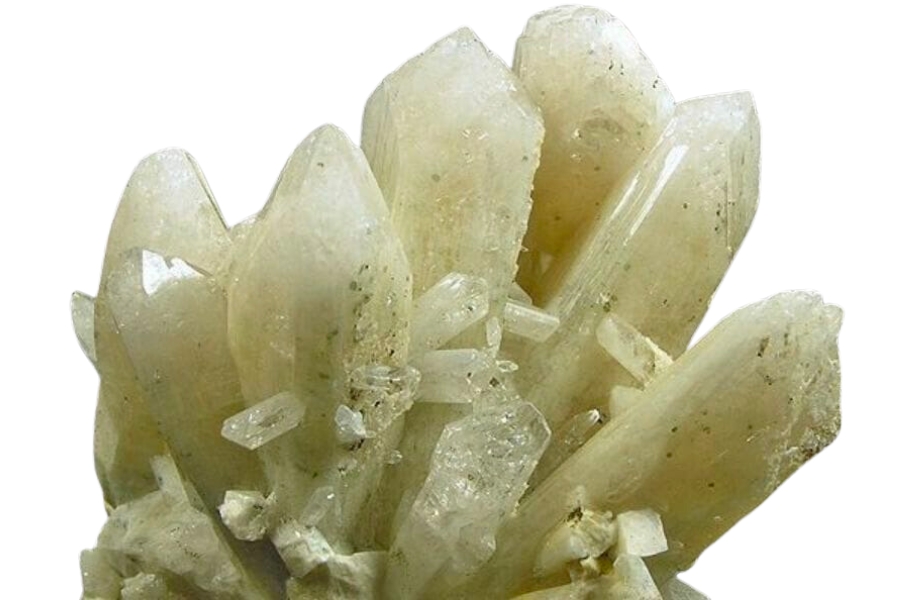
Danburite is a gemstone first discovered in Danbury, Connecticut, in 1839. It is a calcium borosilicate mineral usually found in shades of white, grey, yellow, and pink.
It has a unique crystal structure consisting of four-sided pyramids with an octahedral base. Its relative rarity makes it a highly sought-after stone among collectors and jewelry connoisseurs.
The stone has been used in various cultures throughout history for its metaphysical properties, including spiritual healing, protection from negative energies, and inner peace.
It has also been used to aid communication with the divine and to open the heart chakra for increased love and compassion.
Fun Fact
Danburite is named after the town it was first discovered in, Danbury, Connecticut.Where Danburites are found
Danburite can be found in several locations, including Mexico, Russia, Myanmar, Madagascar, and the USA.
How you can identify a Danburite
Color
Danburite is a sparkling gemstone with a unique color range. It can range from clear to pale yellow, light pink, brown, and grey. It can also have a slight blue or lavender hue.
Hardness
Danburite is considered a very hard mineral, registering 7 on the Mohs Scale of Hardness. This puts it in the same range as quartz and topaz, making it one of the hardest gemstones for jewelry use.
It is tough enough to stand up to everyday wear and is resistant to scratches and abrasions.
Clarity
Danburite has excellent clarity and can appear glass-like in cut stones. It’s usually free of inclusions or flaws, and when cut properly, it has a high degree of transparency and brilliance.
It can also be faceted into beautiful gemstones showing its unique clarity.
Refractive index
Danburite has a high refractive index of 1.636-1.642, which is significantly higher than most other gemstones and minerals.
This is due to the strong birefringence of the material, which causes light to be split into two rays upon entering the stone and creates an optical dispersion effect known as double refraction.
Specific gravity
The specific gravity of danburite is 3.04-3.08, slightly higher than quartz (2.65) and lower than topaz (3.54). It’s denser than most other gemstones but not as dense as some more common gems like a diamond (3.52) and corundum (4.0).
Heliodor – Be3A12(Si6O18)
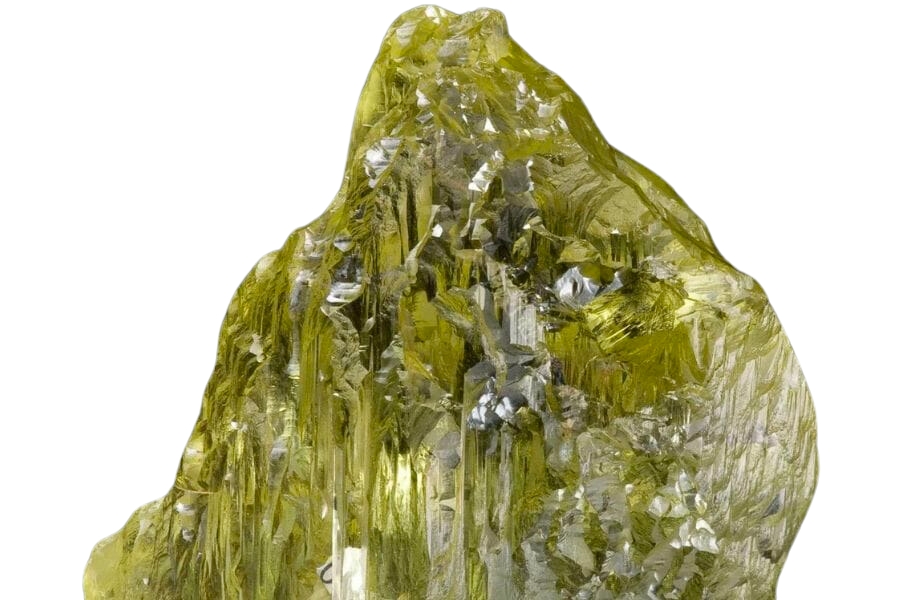
Heliodor is a yellow-green variety of the mineral beryl, which belongs to the beryllium aluminum silicate family. It has been used in jewelry since ancient times and is believed to have originated in India.
Heliodor was first discovered in 1789 by Abraham Gottlob Werner, a German geologist. It is known for its unique yellowish-green hue and has been used to create beautiful jewelry throughout history.
In the 19th century, heliodor was mined extensively in Russia and other parts of Europe, and it is still highly sought after today as a precious gemstone.
It’s often thought of as an emotional stone, said to bring joy, happiness, and luck to its wearer. Its beauty and symbolism make heliodor a popular choice for engagement rings and other pieces of fine jewelry.
Fun Fact The heliodor name comes from the Greek terms “helios” and “doron”. Which literally translates as “gift from the sun”, radiating the power and warmth of sunshine.
Where Heliodors are found
Heliodors can be found in many countries, including Brazil, Madagascar, India, and the United States. Heliodors are also occasionally found in certain gemstone deposits.
How you can identify a Heliodor
Color
A heliodor is a yellow-gold colored gemstone that appears to have a sun-like glow. It has a golden hue with hints of green, brown, and orange.
The color of the gemstone ranges from pale yellow to deep golden yellow, depending on the amount of iron in its crystal structure.
Hardness
Heliodor is a variety of beryl with a hardness of 7.5 to 8 on the Mohs scale. This makes it harder than quartz and softer than topaz, and it can resist scratching from everyday items like coins and keys.
Clarity
Heliodor is a beryl variety that displays high clarity and transparency. Its color ranges from golden to light greenish yellow, and its clarity is often so clear that it is almost indistinguishable from a diamond.
Refractive index
Heliodor has a refractive index of 1.57-1.58, which is relatively high compared to other gemstones like quartz and diamond, which have a refractive index of 1.54 and 2.42, respectively.
This means the heliodor has a higher ability to bend light. Therefore, it appears more brilliant than other gems due to its increased dispersion of light.
Specific gravity
The specific gravity of a heliodor ranges from 2.64 to 2.68, depending on the stone’s origin. This is slightly higher than the average beryl stone, which has a specific gravity of 2.60-2.90.
Legrandite – Zn₂
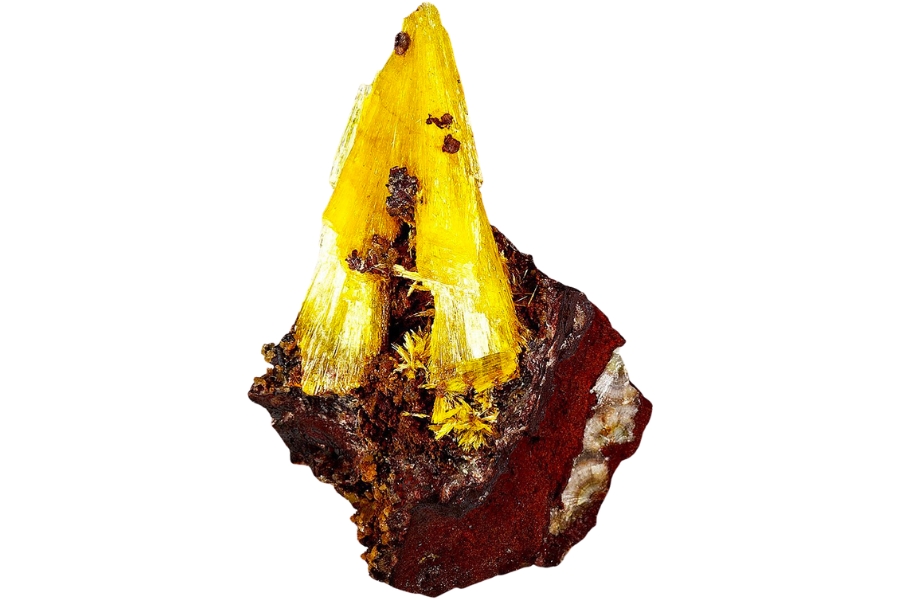
Legrandite is a rare mineral consisting of zinc, manganese, and iron. Initially misclassified as willemite, it was later re-examined and identified as a new species by mineralogist John Sinkankas in 1976 and named after his friend, mineral collector René Legrand.
The mineral is found only at this one location and has since become a highly sought-after specimen among collectors.
It typically occurs as prismatic crystals with a yellowish to greenish hue and often forms radiating clusters of crystals.
In its purest form, legrandite contains no other elements except zinc, manganese, and iron – making it unique among other minerals with similar compositions. Its rarity has made it particularly desirable to collectors all over the world.
Fun Fact
Legrandite is a rare mineral that is fluorescent under ultraviolet light.Where Legrandites are found
Legrandite minerals can be found in the Ojuela Mine near Mapimi, Durango, Mexico.
How you can identify a Legrandite
Color
Legrandite is a rare mineral with a unique, eye-catching color. Its hue can range from yellow to orange, sometimes with a hint of red or pink.
Hardness
Legrandite has a hardness of 4.5-5 on the Mohs scale, making it a relatively soft mineral. It can be easily scratched by fingernails but is harder than talc and gypsum. Legrandite is softer than many other minerals, such as quartz and feldspar.
Clarity
Legrandite is highly sought after for its remarkable clarity. It is known for its vitreous luster and high transparency, with gemstones of top quality having an almost glass-like clarity.
Refractive index
Legrandite has a refractive index that ranges from 1.634 to 1.644, with an average of 1.639. It is biaxial, meaning that it has two different indices of refraction depending on the direction of light passing through it, and its birefringence is 0.010.
Its dispersion ranges from 0.017 to 0.019, with an average of 0.018, and its optical character is uniaxial negative.
Specific gravity
The specific gravity of legrandite is approximately 3.40, which is relatively high for a mineral. This indicates that the mineral is denser than most other minerals, making it slightly heavier than average.
Legrandite’s specific gravity results from its complex chemical composition, which includes sodium, zinc, manganese, and other trace elements.
Orpiment – As ₂S ₃
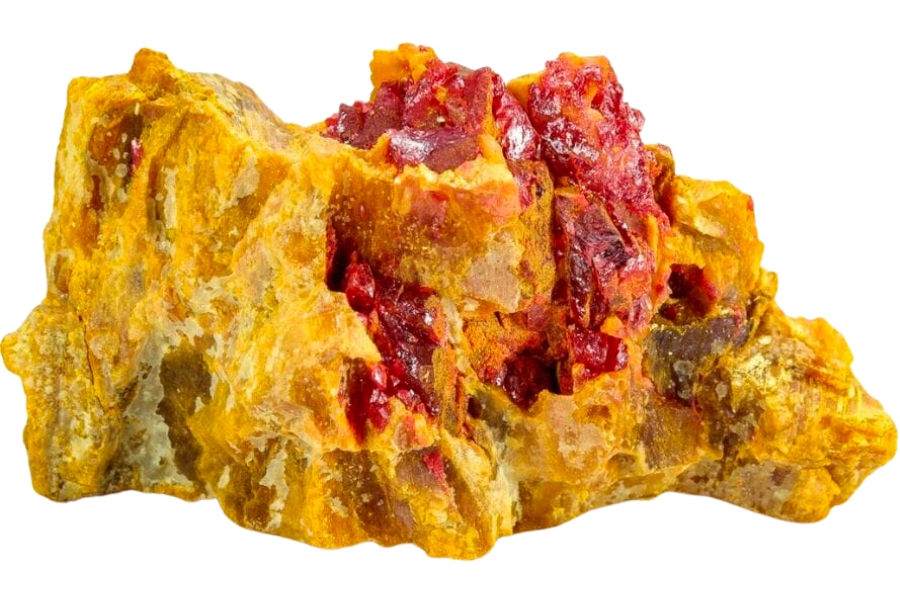
Orpiment is a naturally occurring arsenic sulfide mineral found in volcanic fumaroles and hot springs. It has been used since antiquity as a coloring agent in paints, cosmetics, and dyes.
Its name is derived from the Latin, “auripigmentum”, which translates to “golden pigment” due to its golden-yellow color. In the Middle Ages, it was used as a medicine and was believed to have medicinal properties.
During the Renaissance, orpiment was widely used as an artist’s pigment for painting and illuminated manuscripts due to its bright yellow color. It has also been used for centuries in alchemy as an ingredient in several compounds.
Orpiment is still used today to make yellow pigments for paints and dyes, but it is not widely available due to its toxicity when inhaled or ingested.
Fun Fact
Orpiment is one of the oldest known pigments and was used by ancient civilizations to paint murals, manuscripts, and other artwork. Where Orpiments are found
Orpiments can be found in mineral deposits in some parts of the world, such as China, Tibet, and Turkey.
How you can identify an Orpiment
Color
Orpiment is a yellow-orange color, similar to a mustard or saffron hue. It’s a deep and vibrant color with hints of gold and warmth. At times it can appear slightly greenish but still holds onto its dominant yellow-orange tone.
Hardness
Orpiment is a soft mineral with a hardness of 2 on the Mohs scale. It’s brittle and can easily be scratched with a fingernail or other objects.
Clarity
Orpiment is a bright yellow mineral that has a strong clarity. Its transparency ranges from transparent to translucent, allowing light to pass through it, but not allowing objects to be seen clearly.
It has a vitreous luster and is generally clean and free of any inclusions or blemishes, giving it a high degree of clarity and purity.
Refractive index
The refractive index of orpiment measures how much light is bent when it passes through the material. It has a high refractive index, meaning light is bent more when passing through it than in the air.
Specific gravity
The specific gravity of orpiment is 3.49, meaning it has an intermediate density between a mineral and a metal. It is heavier than most other minerals but lighter than most metals.
Orpiment has higher specific gravity than quartz and calcite but lower than hematite and galena.
Scapolite – (Na,Ca)₄(Al,Si)₃Si₆O₂₄)(Cl,CO₃)
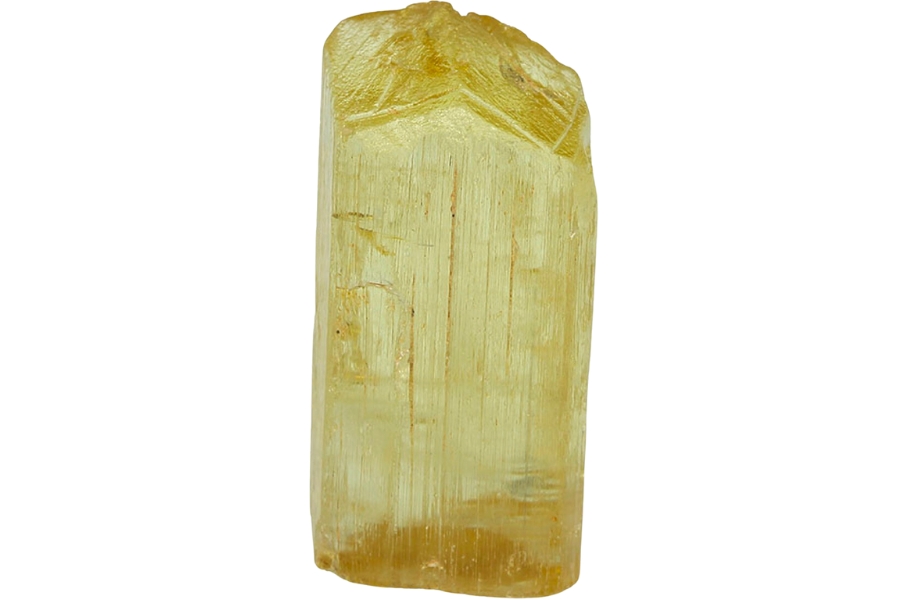
Scapolite is a rare mineral composed of sodium, calcium, aluminum, and silicate. It can be found in various colors, including yellow, pink, purple, and white.
It was first discovered in 1819 by French mineralogist Rene Just Haüy, and its name comes from the Greek word ‘skapos’, which means ‘rod’ due to its rod-like shape when viewed under a microscope.
Scapolite is found in igneous rocks across the globe, such as Brazil, Canada, and India. It also forms in metamorphic rocks such as marble. Its crystals are often twinned.
Scapolite has been used for centuries for jewelry making due to its attractive color and shine but is rarely used today due to its rarity.
Fun Fact
Scapolite was first discovered in Northern Burma (Myanmar) in 1913.Where Scapolites are found
Scapolites are found in many places, including Myanmar, Canada, the United States, Mexico, India, Madagascar, and Europe. They are most commonly found in metamorphic rocks such as gneiss and schist.
How you can identify a Scapolite
Color
Scapolite is a mineral found in shades of yellow, white, green, pink, and blue. Its hue ranges from a light pastel yellow to a deep greenish-blue. It can also have tints of pink or purple in certain specimens.
The color of scapolite is unique and captivating; it often appears to be almost luminescent in the light.
Hardness
Scapolite is a mineral with a hardness on the Mohs scale of 5.5 to 6.5, making it relatively hard but not as hard as some other minerals. It is not a scratch-resistant mineral and can be scratched with things like a steel knife or glass plate.
It also has low cleavage and fracture, meaning it won’t break apart easily when cut or pounded with a hard object.
Clarity
Scapolite has good clarity, with its vitreous luster making it sparkle in the light. It is usually transparent to translucent, and its color ranges from colorless to yellow, green, blue, and purple.
Refractive index
Scapolite has a refractive index between 1.54 and 1.58, depending on the variety of scapolite. It is higher than quartz but lower than most gemstones, making it helpful in creating brighter and more vivid light colors when cut into a gemstone.
Its birefringence is usually low, making it less likely to show double refraction in faceted stones.
Specific gravity
Scapolite can range from 2.6 to 3.3, depending on the exact composition. The higher the proportion of sodium in scapolite, the lower the specific gravity, while a higher calcium content will result in higher specific gravity.
Generally speaking, scapolite has a relatively low specific gravity compared to other minerals.
Sphene – CaTiSiO₅
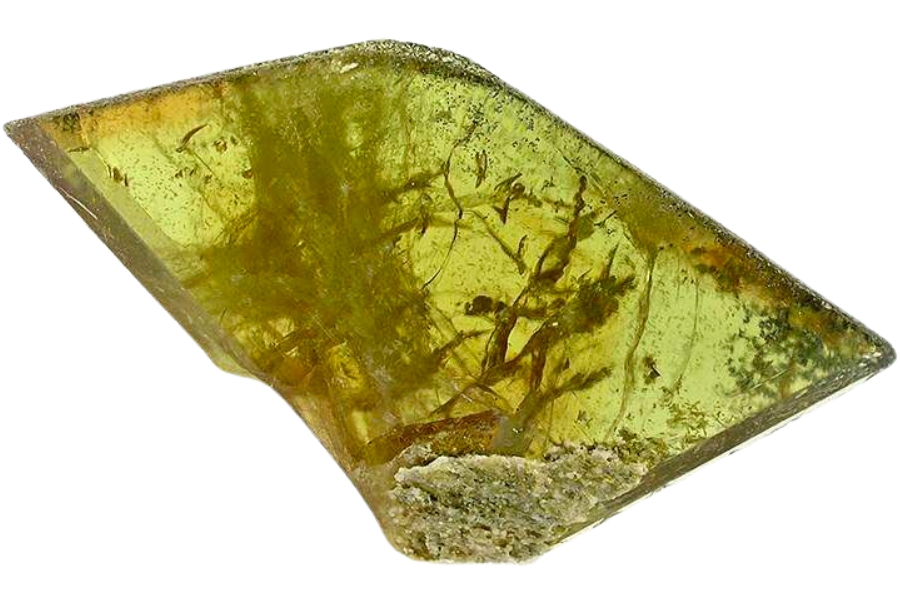
Sphene is a mineral of incredible beauty and rarity. It’s composed of calcium, titanium, and silicate.
Sphene was first discovered in 1801 by a German geologist named Abraham Gottlob Werner and was named after the Greek word “sphenos” meaning wedge. Since then, it has been used for jewelry making.
Sphene also has been used to make lens elements for microscopes due to its high refractive index, which allows for greater magnification than other lenses.
It’s also believed to benefit people suffering from depression, anxiety, and other mental health issues.
Fun Fact
Did you know? Sphene also goes by the name Titanite. So, don't be confused!Where Sphenes are found
Sphenes can be found in areas of the Northern Hemisphere, including Europe, Asia, and North America. They are generally found near wetlands, marshes, ponds, rivers, and lakes.
How you can identify a Sphenes
Color
Sphenes can be seen as having a yellowish-green to yellowish-brown hue, sometimes with flashes of orange or red.
Hardness
Sphene has a hardness of 5.5 to 6 on the Mohs scale. It is slightly softer than quartz, which has a hardness of 7, but much harder than talc, which has a hardness of 1.
Sphene is considered exceptionally durable and suitable for most jewelry applications, although it should not be exposed to harsh chemicals or extreme temperatures.
It’s also prone to scratches, so care should be taken when cleaning or wearing it.
Clarity
A sphene gemstone has remarkable clarity, with a combination of brilliance and fire that gives it an almost electric sparkle.
It’s slightly hazy due to its high refraction index and the presence of inclusions, but the vivid flashes of color create an attractive contrast that helps to make up for any lack of clarity.
Refractive index
The refractive index of Sphene is higher than that of most other gemstones, ranging from 1.742 to 1.858.
It has high birefringence, meaning the two optical axes of the gemstone have different refractive indices, resulting in a doubling of images when viewed through a microscope.
Specific gravity
The specific gravity of a Sphene is 3.47-3.72, which is considered higher than the average for gemstones.
This indicates that it has a relatively high density, meaning that it is heavier than many other types of stones and can be used to help distinguish it from stones of similar size and color.
Sulfur Crystal – S
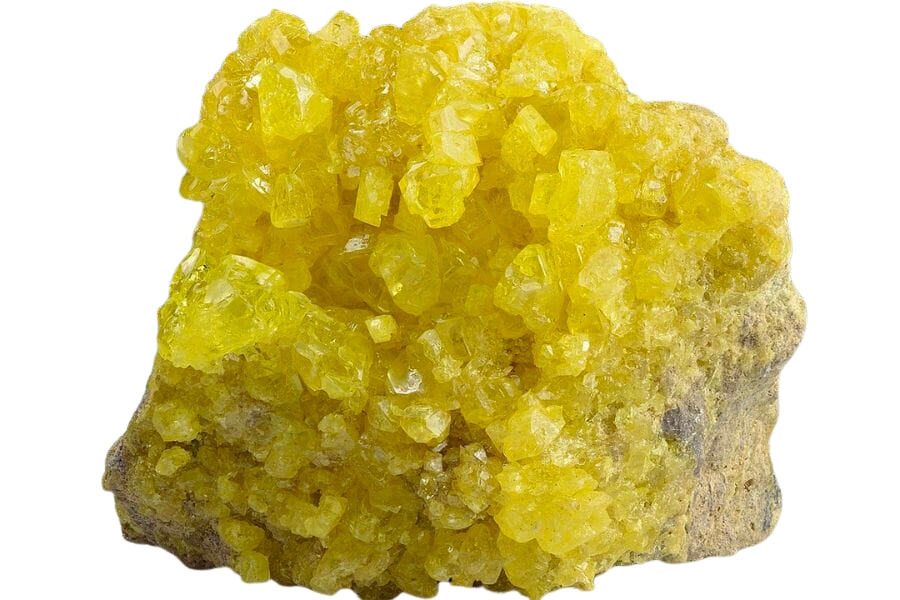
Sulfur crystals are a form of elemental sulfur, a naturally occurring non-metallic chemical element with the atomic number 16. It has a wide variety of uses and has been used by many cultures throughout history.
It was used in ancient times in medicine, agriculture, and religious ceremonies. In the Middle Ages, it was used for its antiseptic properties and to make gunpowder.
More recently, it has produced rubber, explosives, and dyes. Its crystal form is also popular amongst metaphysical practitioners who use it to help balance energies within their environment.
Sulfur crystals are known for their bright yellow color and pungent smell often described as ‘rotten eggs.’ They are usually found near volcanic areas or hot springs due to their volatility when exposed to heat or flame.
Fun Fact Did you know that sulfur crystals are known to be shape shifters? They spontaneously change shape according to the temperature. Pretty cool, huh?
Where Sulfur Crystals are found
Sulfur crystals can be found in volcanic regions such as Italy, Indonesia, and Iceland. They can also be found in hot springs and other hydrothermal areas.
How you can identify Sulfur Crystals
Color
Sulfur crystals are yellow, ranging from pale lemon to deep gold. They have a bright and vibrant hue, often described as “sunny”. The intensity of the yellow color depends on the purity of the sulfur.
Hardness
Sulfur crystals are generally considered soft, with a hardness of 1.5-2 on the Mohs scale. They can be easily scratched or dented with something as soft as a fingernail or a copper coin and can be pulverized into a powder with minimal effort.
Despite this, sulfur crystals are still relatively durable and can withstand wear and tear without being destroyed.
Clarity
Sulfur crystals are generally clear and transparent, with a distinct yellow hue. They have a glassy luster and are typically found in prismatic, rhombic, or cuboidal shapes.
The individual crystals can be large and have sharp edges, making them easy to identify and distinguish from other minerals.
Refractive index
Sulfur crystals have a refractive index ranging from 1.8 to 2.01, depending on the wavelength of light used for measurement.
This means that sulfur crystals have a higher refractive index than most other minerals, allowing them to bend and refract light more effectively than other substances.
Specific gravity
The specific gravity of sulfur crystals is 2.07, meaning they are slightly less dense than water. This is because sulfur has a lower molecular weight than water and thus takes up more space for a given mass.

